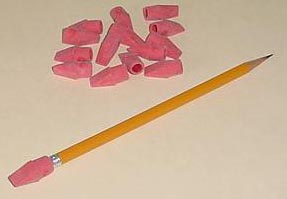Eraser
|
|
Alternate uses: Eraser (disambiguation)
Eraser_closeup.jpg
An eraser is an article of stationery that is used for removing pencil writings. Erasers have a rubbery consistency, and they are often white, brown or pink although with modern materials they can be any colour at all. Many pencils are equipped with an eraser on one end. Expensive erasers may contain vinyl or plastic materials in addition to rubber. In English and other Commonwealth Englishes the term 'rubber' is often used in place of eraser -- the term not causing confusion with the American slang term 'rubber', meaning condom.
An eraser can also be used on workboards such as whiteboards or chalkboards. The traditional chalkboard eraser is a rectangular block made of felt. A handeraser is a felt eraser that attaches to the side of the hand.
Types
A variety of specialized erasers are manufactured today.
The type of eraser often attached to pencils is usually pink or red, and has a smooth, rubbery texture. It is good for most erasing purposes, though it tends to smear and can damage the paper if used too heavily. It leaves eraser residue that must be brushed away; care must be taken in brushing away residue, as the eraser particles can leave marks on the paper.
Another eraser type that is popular with artists is the art gum eraser, made of soft, coarse rubber. It is especially suited to removing large areas, and does not damage the paper. This eraser leaves a lot of eraser residue, however, and is not very precise. Art gum erasers are commonly tan or brown.
The kneaded eraser is also well-known among artists. It is usually made of a grey material and resembles putty or gum. Its strength is that it does not leave eraser residue, and thus lasts much longer than other erasers. It erases by "absorbing" graphite particles; it can be used for precision erasing, to create highlights, or for detailing work. It is not well-suited to completely erasing large areas, and may smear or stick if it becomes too warm.
Soft vinyl erasers have a plastic-like texture, and are similar in erasing characteristics to the standard pink erasers; they are somewhat softer, though, and are therefore less likely to damage the paper. Vinyl erasers are commonly white.
Erasers come in several shapes and sizes. In addition to those that come attached to pencils, they may also be rectangular blocks (block or wedge eraser), or conical caps that can slip onto the end of a pencil (cap eraser). A barrel or click eraser is a device shaped like a pencil, but instead of being filled with pencil lead, its barrel contains a retractable cylinder of eraser material. Decorative erasers are made in a wide variety of shapes and colours to suit their themes (such as musical notes, animals, confectionery), and they are acquired more for their decorative nature than for any practical use.
Some people enjoy chewing on erasers, though this is not generally the intended use of those who manufacture them.
History
In 1770, scientist Joseph Priestley noted, "I have seen a substance excellently adapted to the purpose of wiping from paper the mark of black lead pencil." Throughout Europe, pencil marks were rubbed out of paper using small cubes of rubber. Blocks of the material are still used for this purpose, and known as 'rubbers' in England and Australia, causing occasional amusement to Americans, to whom a 'rubber' is a latex condom.
Eraser_wedge.jpg
Wedge eraser
Also in 1770, Edward Naime, an English engineer, is credited with creating the first rubber eraser. Prior to using rubber, breadcrumbs were used as erasers. Naime says he inadvertently picked up a piece of rubber instead of breadcrumbs, discovered rubber's erasing properties, and began selling rubber erasers.
However, rubber in its raw form was inconvenient, since it was perishable and would go bad over time. In 1839, inventor Charles Goodyear discovered the process of vulcanization, a method that would cure rubber and make it a durable material. Rubber erasers became common with the advent of vulcanized rubber.
Template:Commons In 1858, Hyman Lipman of Philadelphia, Pennsylvania, USA, received the first patent for attaching an eraser to the end of a pencil. It was later invalidated because it was determined to be simply a composite of two devices rather than an entirely new product.de:Radiergummi ms:Getah pemadam id:Penghapus ja:消しゴム zh:橡皮擦 sv:Radergummi

